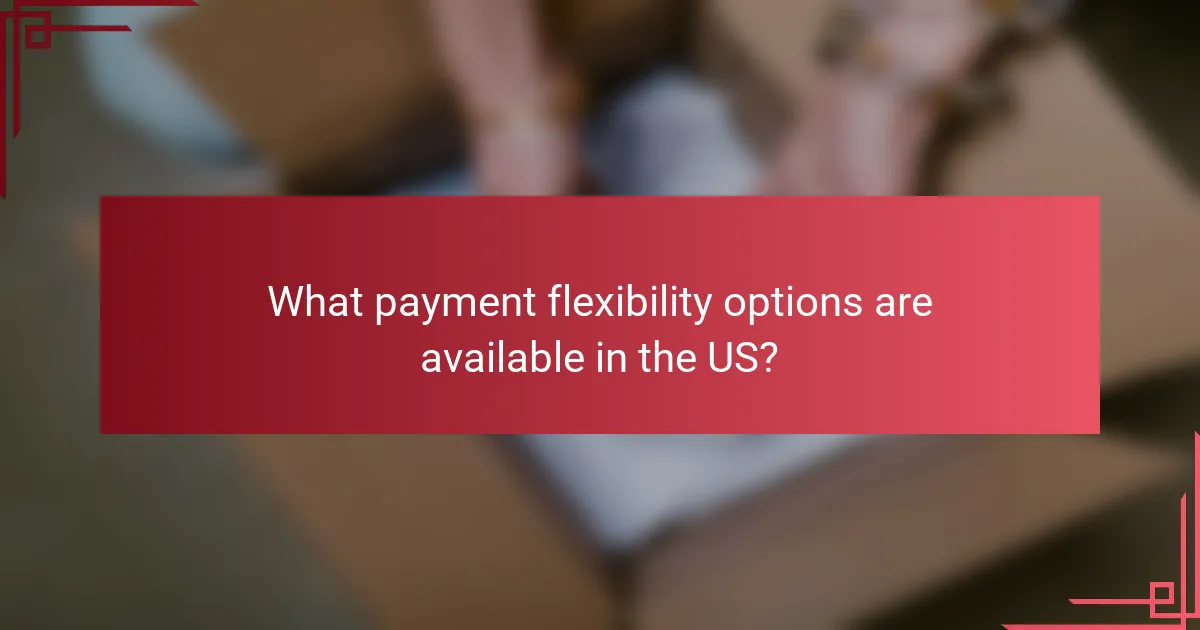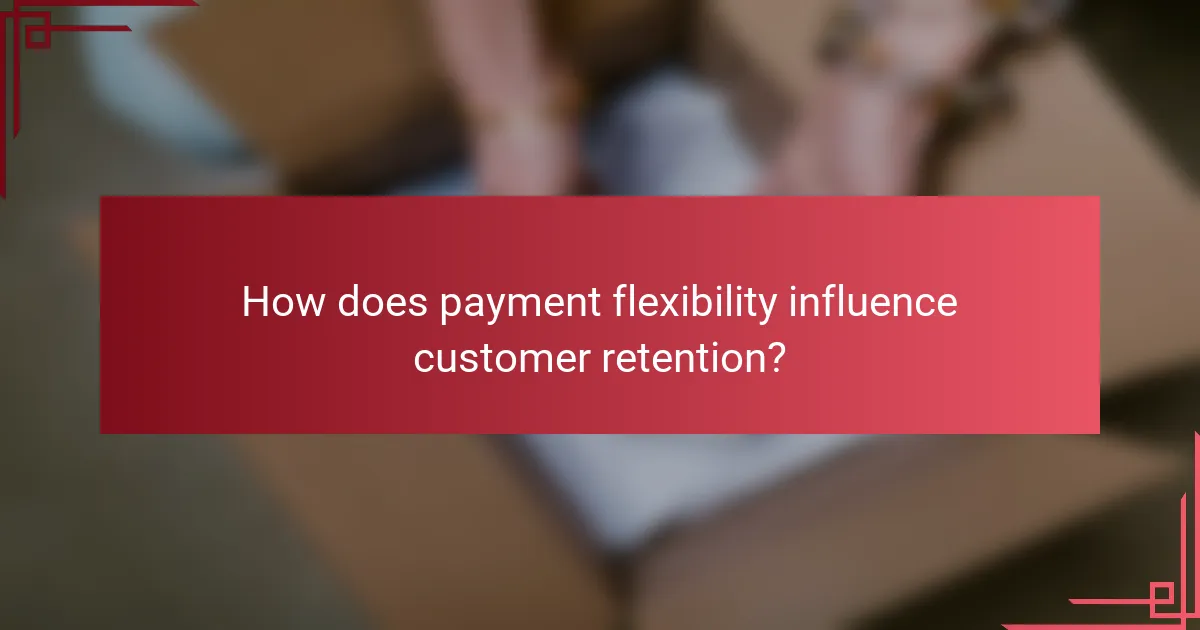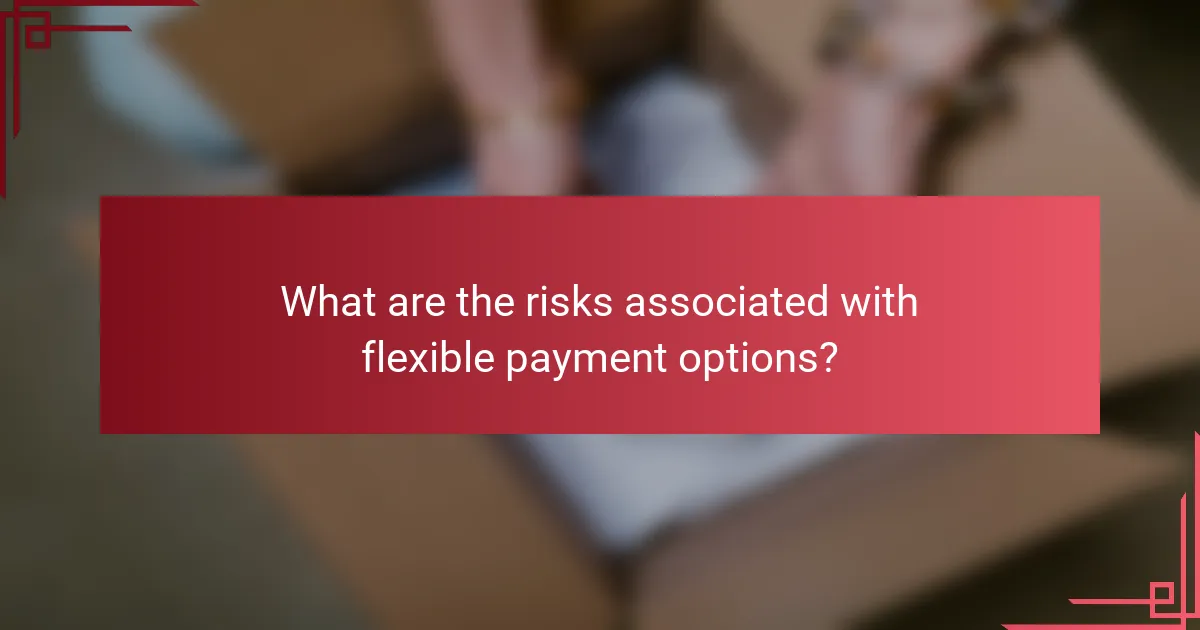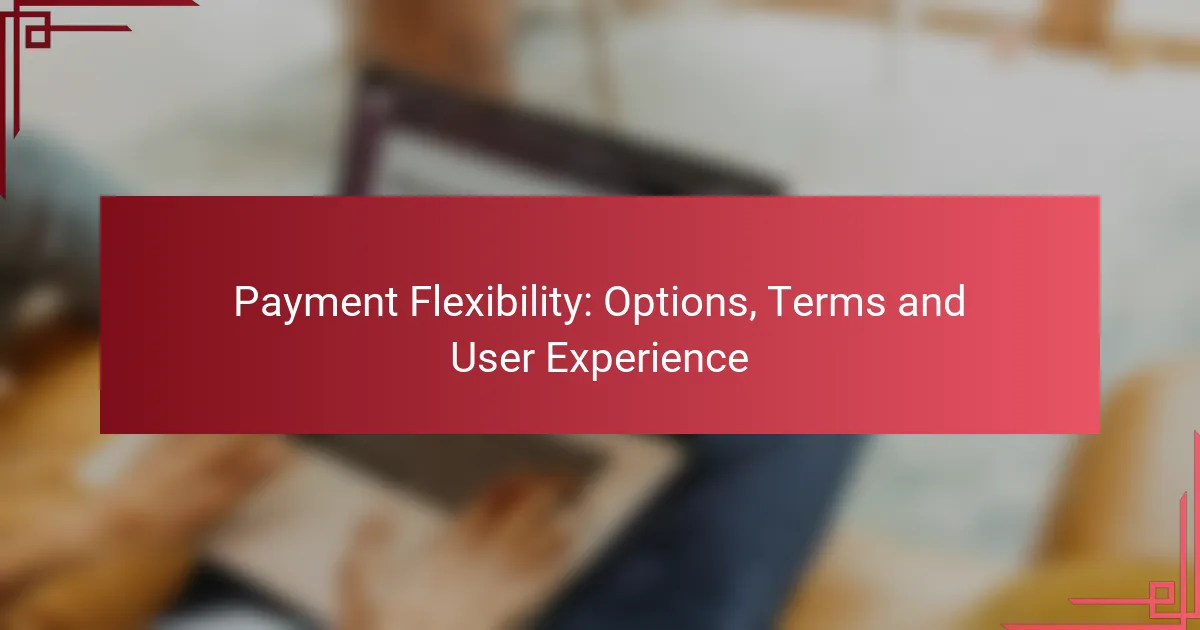Payment flexibility is essential for consumers seeking to manage their finances effectively, with options such as installment plans, deferred payments, and subscription models catering to diverse needs. The terms of these payment methods significantly impact user experience, influencing perceptions of affordability and accessibility. By prioritizing clear communication and user-friendly interfaces, businesses can enhance customer satisfaction and foster trust, ultimately encouraging repeat business.

What payment flexibility options are available in the US?
In the US, various payment flexibility options cater to different consumer needs, allowing individuals to manage their finances more effectively. These options include installment plans, deferred payments, subscription models, pay-as-you-go systems, and credit options, each with unique features and considerations.
Installment plans
Installment plans allow consumers to pay for products or services over a set period, typically through fixed monthly payments. This option is common for larger purchases, such as electronics or furniture, where the total cost is divided into manageable amounts.
When considering installment plans, check for interest rates and any associated fees. Some retailers offer interest-free options, while others may charge significant interest, impacting the overall cost.
Deferred payments
Deferred payments enable consumers to delay payment for a specified period, often without interest. This option is useful for those who need immediate access to a product but may not have the funds available at the time of purchase.
Be aware of the terms surrounding deferred payments, including the duration of the deferment and any penalties for late payment. Missing the deadline can result in high interest rates being applied retroactively.
Subscription models
Subscription models involve regular payments for ongoing access to a service or product, such as streaming services or meal kits. This approach can provide convenience and predictability in budgeting.
Evaluate the total cost of subscriptions over time and consider whether the service meets your needs. Many subscriptions offer trial periods, allowing you to assess value before committing long-term.
Pay-as-you-go systems
Pay-as-you-go systems charge consumers based on actual usage, making them ideal for services like utilities or mobile plans. This flexibility allows users to control spending by only paying for what they consume.
Monitor your usage closely to avoid unexpected charges. Some providers may offer discounts for prepayment or bulk usage, which can lead to savings.
Credit options
Credit options, such as credit cards or personal loans, provide consumers with immediate purchasing power. These options can be beneficial for managing cash flow but come with the responsibility of repayment, often with interest.
Before using credit, assess your ability to repay the balance to avoid high interest costs. Consider using credit responsibly by keeping balances low and making timely payments to maintain a good credit score.

How do payment terms affect user experience?
Payment terms significantly influence user experience by shaping how customers perceive the affordability and accessibility of a purchase. Clear and flexible payment options can enhance satisfaction and encourage repeat business.
Impact on purchasing decisions
Payment terms can be a decisive factor in whether a customer completes a purchase. Options like installment plans or deferred payments can make higher-priced items more attainable, leading to increased sales. For example, offering a 0% interest installment plan can attract buyers who might otherwise hesitate due to upfront costs.
Conversely, rigid payment terms may deter potential customers. If a buyer feels pressured to pay in full immediately, they may abandon their cart. Retailers should consider offering a variety of payment options to cater to different financial situations.
Transparency in fees
Clear communication about fees associated with payment options is crucial for a positive user experience. Hidden fees can lead to frustration and distrust, causing customers to reconsider their purchase. Providing upfront information about any additional costs, such as processing fees or interest rates, fosters transparency.
For instance, if a payment plan includes a service fee, it should be clearly stated before the checkout process. This transparency helps customers make informed decisions and reduces the likelihood of chargebacks or disputes later on.
Flexibility in repayment
Flexible repayment options enhance user experience by accommodating diverse financial situations. Allowing customers to choose their repayment schedule, such as weekly or monthly payments, can significantly increase their comfort level with a purchase. This flexibility can lead to higher conversion rates and customer loyalty.
However, it’s essential to balance flexibility with clear terms. Customers should understand their obligations, including any penalties for late payments. Providing a straightforward repayment schedule can help prevent misunderstandings and promote responsible borrowing.

What are the best practices for offering payment flexibility?
To effectively offer payment flexibility, businesses should prioritize clear communication, user-friendly interfaces, and responsive customer support. These practices enhance the overall user experience and build trust, making it easier for customers to navigate payment options.
Clear communication of terms
Clearly outlining payment terms is essential for customer understanding and satisfaction. This includes specifying due dates, interest rates, and any fees associated with late payments. Use straightforward language and avoid jargon to ensure all customers can comprehend the terms easily.
Consider providing a summary of key terms at the point of sale, along with detailed explanations in FAQs or help sections. This transparency helps prevent misunderstandings and fosters a positive relationship with customers.
Easy-to-use interfaces
An intuitive interface is crucial for facilitating payment flexibility. Customers should be able to easily navigate through payment options, whether on a website or mobile app. Simple layouts, clear buttons, and minimal steps can significantly enhance user experience.
Incorporating features like saved payment methods and one-click payments can streamline the process. Additionally, ensure that the interface is responsive across devices to accommodate users accessing the platform from smartphones, tablets, or desktops.
Responsive customer support
Providing responsive customer support is vital for addressing payment-related inquiries and issues. Customers should have access to multiple support channels, such as live chat, email, and phone support, to resolve their concerns quickly.
Consider implementing a knowledge base or help center that includes common questions and troubleshooting tips. This can empower customers to find solutions independently while still having the option to reach out for assistance when needed.

How does payment flexibility influence customer retention?
Payment flexibility significantly enhances customer retention by accommodating diverse financial situations and preferences. When customers feel they have options that suit their needs, they are more likely to remain loyal to a brand.
Increased loyalty
Offering various payment methods, such as credit cards, digital wallets, and installment plans, fosters a sense of loyalty among customers. When consumers can choose how and when to pay, they often feel more valued and understood by the brand.
For example, a retailer that allows customers to split payments or offers deferred payment options can create a more personalized shopping experience. This approach can lead to stronger emotional connections with the brand, ultimately boosting loyalty.
Higher repeat purchases
Flexible payment options can lead to higher repeat purchases as customers are more likely to return when they have favorable payment terms. When customers can manage their finances better through payment flexibility, they are inclined to buy more frequently.
For instance, a subscription service that allows customers to pause payments or offers discounts for upfront payments can encourage ongoing engagement. This strategy not only increases sales but also enhances customer satisfaction, leading to a cycle of repeat business.

What are the risks associated with flexible payment options?
Flexible payment options can lead to various risks, primarily involving increased debt and potential fraud. Understanding these risks is crucial for managing finances effectively when utilizing such payment methods.
Potential for increased debt
Flexible payment options often allow consumers to make purchases without immediate full payment, which can lead to accumulating debt. Users may find it easy to overspend, as the initial financial burden appears lower than it actually is.
For instance, a buy-now-pay-later service might let you purchase an item for $300, payable in installments over several months. If you take on multiple such payments, your total debt can quickly escalate, making it hard to manage monthly expenses.
To avoid falling into debt, set a strict budget and limit the number of flexible payment plans you use simultaneously. Regularly review your outstanding balances to stay on track.
Fraud risks
Flexible payment options can expose users to various fraud risks, including identity theft and unauthorized transactions. Scammers often exploit these systems, targeting individuals who may not be vigilant about their financial information.
For example, if a payment service lacks robust security measures, your personal data could be compromised, leading to fraudulent charges. Always ensure that the payment platform you choose has strong encryption and fraud protection policies in place.
To mitigate fraud risks, use unique passwords for payment accounts and enable two-factor authentication whenever possible. Regularly monitor your financial statements for any unusual activity to catch potential fraud early.

How can businesses implement flexible payment options?
Businesses can implement flexible payment options by offering various methods that cater to customer preferences, such as credit cards, digital wallets, and installment plans. This approach enhances user experience and can lead to increased sales and customer loyalty.
Partnerships with payment processors
Establishing partnerships with reliable payment processors is crucial for enabling flexible payment options. Businesses should evaluate processors based on fees, transaction speed, and supported payment methods. Popular processors like PayPal, Stripe, and Square offer diverse solutions that can accommodate different customer needs.
When selecting a payment processor, consider the integration process and customer support. A seamless integration can reduce friction during checkout, while responsive support can help resolve issues quickly, ensuring a positive user experience.
Utilizing technology platforms
Leveraging technology platforms can significantly enhance the flexibility of payment options. E-commerce platforms like Shopify and WooCommerce provide built-in features for managing various payment methods, including subscriptions and pay-later options. These platforms often support multiple currencies, making them suitable for international customers.
Additionally, businesses can use software solutions to analyze customer payment preferences and optimize their offerings accordingly. Regularly reviewing payment performance can help identify trends and adjust strategies to meet evolving customer demands.
